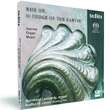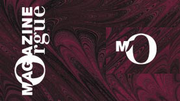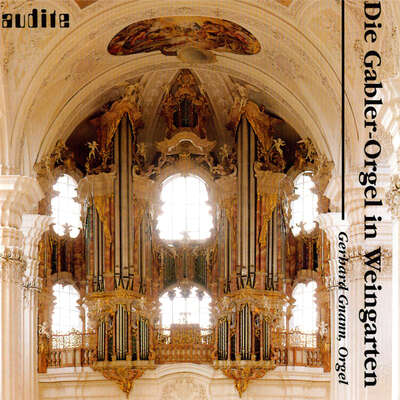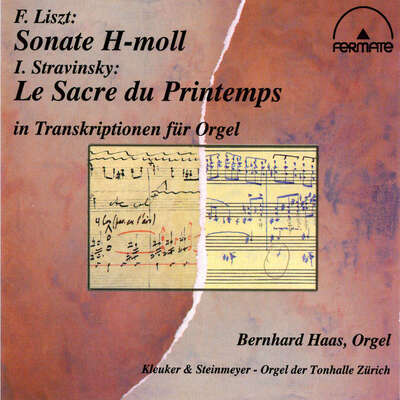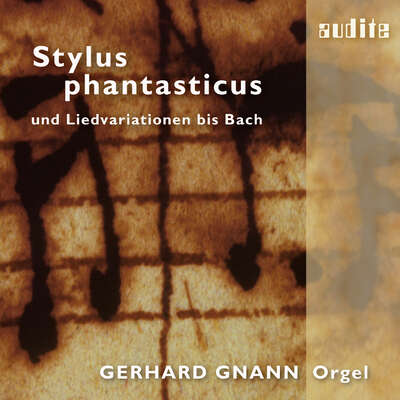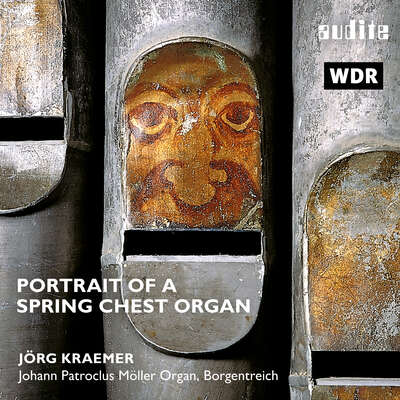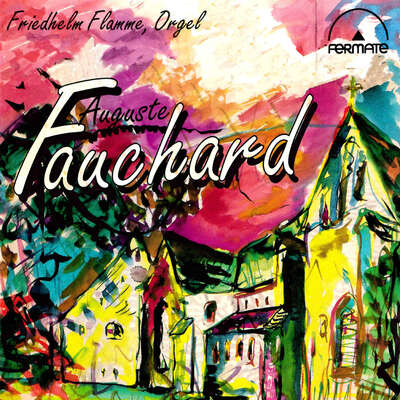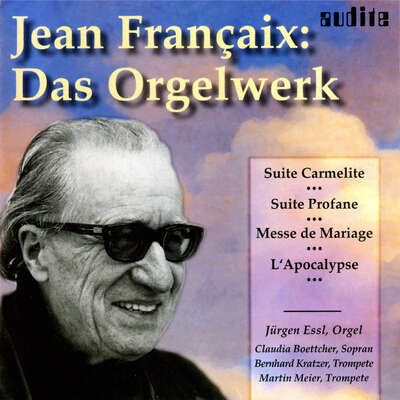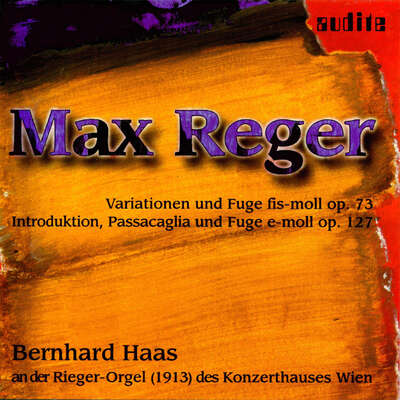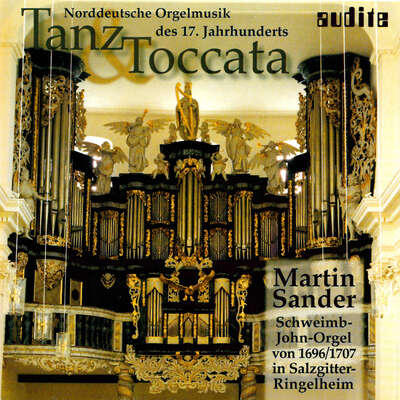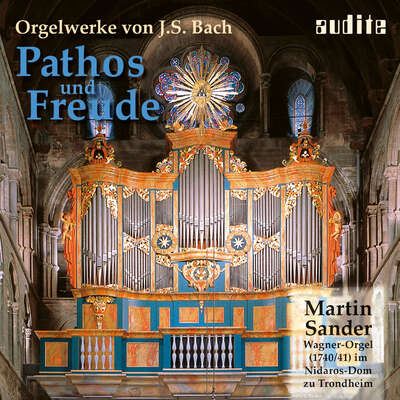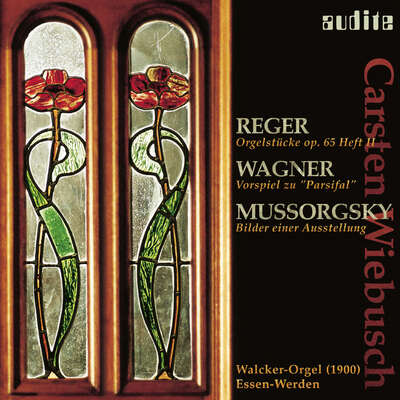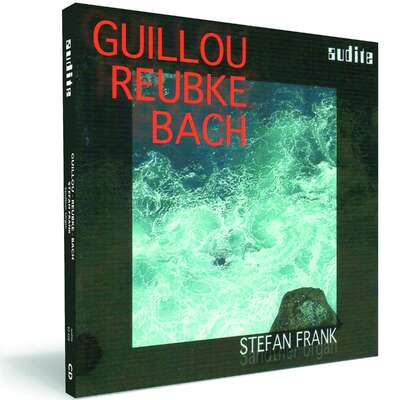
There is probably no instrument better suited to a Surround recording than the organ. The large Klais/Mayer Organ of the Basilica St. Johann in Saarbrücken proves itself to be practically predestined for this, thanks to ist differentiation of musical characteristics and spatial separation into...more
"This is a wonderful disc for any organ music-lover. One can revel in these works if one wishes for the sheer beauty of their sound, without having to relate to their theological foundations. Plaudits to Bernhard Leonardy and Audite’s fine recording." (Fanfare)
Details
| Rise up, o Judge of the Earth - Sacred Organ Music | |
| article number: | 92.564 |
|---|---|
| EAN barcode: | 4022143925640 |
| price group: | ACX |
| release date: | 1. August 2006 |
| total time: | 70 min. |
Bonus Material
Informationen
There is probably no instrument better suited to a Surround recording than the organ. The large Klais/Mayer Organ of the Basilica St. Johann in Saarbrücken proves itself to be practically predestined for this, thanks to ist differentiation of musical characteristics and spatial separation into three partial mechanisms. The Italian disposed Great Organ on the rear balcony, the large French Récit (Swell) and a magnificent Chamade with three horizontal reeds (spanische Trompeten) sonically fill the church space, guaranteeing an overwhelming spatial experience for the churchgoer – and also for the listener of “Rise Up, o Judge of the Earth – Sacred Organ Music”.
Music and liturgy constantly form an important unity in Christian faith; since the Gothic period, the organ has been intimately bound with the formation of liturgical ceremonies as the symbol of liturgical music. The fascination emanating from its majestic, weighty, opulent sound remains interrupted to the present day. These instruments, often visually impressive as well, so firmly bound to their ecclesiastical environments, encompass the complete range of human hearing – and the music rarely fails to make its impact.
Bernhard Leonardy presents works ranging from French romanticism to contemporary organ music on this SACD, produced in cooperation with the Saarland Broadcasting Company. One unifying element, the concept of justice so central to Christian faith, is common to all the works included here: the Organ Sonata on the 94th Psalm by the congenial Liszt-pupil Julius Reubke (1834-1858), Kurt Hessenberg’s (1908-1994) Fantasia on “Sonne der Gerechtigkeit” (Sun of Justice) for Organ, Op. 66, The Sermon on the Mount, Op. 36 by Fred M. Bauersachs (*1930) and the Magnificat: A Triptych on the Melody of the Eighth Tone by Heino Schubert (*1928). The recital comes round full circle with a free improvisation on “Nun jauchzt dem Herren, alle Welt” (Make a Joyful Noise to the Lord, All Ye Lands). This elite form of organ playing has lost none of its fascination since the Baroque: it is indeed living liturgy.
Thanks to Surround-Layer, you can enjoy the concept of sound engineer Thomas Becher with an SACD player and the appropriate loudspeaker arrangement in the comfort of your home.
Special features of this production are the Special Media Files on the audite website, where you can find the Disposition of the Klais/Mayer-Organ in St. Johann and further commentaries concerning the recording and organ expansion.
Reviews
Magazine de l'Orgue | Numéro 91, 2e trimestre 2007 | Jean Ferrard | September 1, 2007
Ludger Böckenhoff, directeur de cette maison de production, m'a plusieursMehr lesen
American Record Guide | July/August 2007 - Volume 30, Number 6 | Jerry Dubins | July 1, 2007
No slight is intended to the composers of the works on this disc or to the playing of Bernhard Leonardy in suggesting that the main attraction here isMehr lesen
Speaking of the program, I must confess to being unfamiliar with all of the music on this CD, and with all but two of its composers. Heino Schubert (b. 1928) was, for many years, cathedral organist at the Münsterkirche in Essen. Currently retired, Schubert has won a number of prestigious composition prizes for his sacred and instrumental works. His Magnificat: A Triptych on the Melody of the 8th Tone (Hypomyxolidian for the modally minded), is a meditation on the Trinity. Beginning and ending with chimes, the 1963 piece is in a vein that will not be foreign to listeners who know their Hindemith.
Julius Reubke (1834-1858) will probably be the most recognized name among the five composers here. He was a student of Franz Liszt who, in the brief 24 years allotted to him, distinguished himself as a brilliant pianist and organist. His fiendishly difficult Bb-Minor Piano Sonata (with which I am familiar) has had a number of recordings. His 94th Psalm recorded here is in fact a three-movement organ sonata in C Minor, the musical intent of its content being elucidated by scriptural quotations. Though it is not likely to be mistaken for any of Brahms's organ pieces, its vocabulary and manner of speech do fall within that general style of expression.
About Fred M. Bauersachs, alas, I am able to tell you zilch, other than the fact that he was born in 1930. The booklet note gives no biographical information about him, and a Google search on his name returned nothing useful. Unfortunately, I do not have access to the specialist organ journals that might shed further light. Die Bergpredigt crams a great deal of theological symbolism and teaching into its seven short sections. In their combined total of less than 12 minutes, Bauersachs manages to offer musical allusions to Jesus's "Sermon on the Mount," "Sermon on a Level Place," and the "Magnificat," Mary's song of praise taken from the Gospel According to St. Luke. The spiritual mysticism and musical vocabulary of the piece tend unavoidably to evoke comparisons with Messiaen.
Kurt Hessenberg (1908-1994) is the only other composer on this program with whom I have some familiarity, but not through his Fantasia über Sonne der Gerechtigkeit ("Sun of Justice"). A Cassandra Records CD of his Second Symphony and Concerto for Orchestra offers but two of his major works from among a catalog of some 135 opus numbers in all genres, including opera. His organ compositions—18 in all—are to his overall output, in terms of relative importance, approximately equal in significance to the organ works of Brahms. Hessenberg's Fantasia is based on a text woven together from three sources that venerate the sun as a symbol of God's goodness, magnificence, and justice. The music's toccata-like style distantly echoes Bach, but Hessenberg's harmonic adventurism leads him to places Bach would have found strange. The piece is quite beautiful in a Poulenc-like way, with familiar and predictable chord progressions in sudden juxtaposition to dissonantly deformed harmonies for the sake of shock.
The program ends with our organ player's own Improvisation on "Nun jauchzt dem Herren, alle Welt. " Also in a free toccata-like style, the piece is a kaleidoscope of colors and sonorities that serves well its subject of jubilation, as well as being a virtuosic display piece that puts the Klais/Mayer organ front and center.
This is a wonderful disc for any organ music-lover. One can revel in these works if one wishes for the sheer beauty of their sound, without having to relate to their theological foundations. Plaudits to Bernhard Leonardy and Audite's fine recording.
Fanfare | July/Aug 2007 | Jerry Dubins | July 1, 2007
No slight is intended to the composers of the works on this disc or to the playing of Bernhard Leonardy in suggesting that the main attraction here isMehr lesen
Speaking of the program, I must confess to being unfamiliar with all of the music on this CD, and with all but two of its composers. Heino Schubert (b. 1928) was, for many years, cathedral organist at the Münsterkirche in Essen. Currently retired, Schubert has won a number of prestigious composition prizes for his sacred and instrumental works. His Magnificat: A Triptych on the Melody of the 8th Tone (Hypomyxolidian for the modally minded), is a meditation on the Trinity. Beginning and ending with chimes, the 1963 piece is in a vein that will not be foreign to listeners who know their Hindemith.
Julius Reubke (1834–1858) will probably be the most recognized name among the five composers here. He was a student of Franz Liszt who, in the brief 24 years allotted to him, distinguished himself as a brilliant pianist and organist. His fiendishly difficult B♭-Minor Piano Sonata (with which I am familiar) has had a number of recordings. His 94th Psalm recorded here is in fact a three-movement organ sonata in C Minor, the musical intent of its content being elucidated by scriptural quotations. Though it is not likely to be mistaken for any of Brahms’s organ pieces, its vocabulary and manner of speech do fall within that general style of expression.
About Fred M. Bauersachs, alas, I am able to tell you zilch, other than the fact that he was born in 1930. The booklet note gives no biographical information about him, and a Google search on his name returned nothing useful. Unfortunately, I do not have access to the specialist organ journals that might shed further light. Die Bergpredigt crams a great deal of theological symbolism and teaching into its seven short sections. In their combined total of less than 12 minutes, Bauersachs manages to offer musical allusions to Jesus’s “Sermon on the Mount,” “Sermon on a Level Place,” and the “Magnificat,” Mary’s song of praise taken from the Gospel According to St. Luke. The spiritual mysticism and musical vocabulary of the piece tend unavoidably to evoke comparisons with Messiaen.
Kurt Hessenberg (1908–1994) is the only other composer on this program with whom I have some familiarity, but not through his Fantasia über Sonne der Gerechtigkeit (“Sun of Justice”). A Cassandra Records CD of his Second Symphony and Concerto for Orchestra offers but two of his major works from among a catalog of some 135 opus numbers in all genres, including opera. His organ compositions—18 in all—are to his overall output, in terms of relative importance, approximately equal in significance to the organ works of Brahms. Hessenberg’s Fantasia is based on a text woven together from three sources that venerate the sun as a symbol of God’s goodness, magnificence, and justice. The music’s toccata-like style distantly echoes Bach, but Hessenberg’s harmonic adventurism leads him to places Bach would have found strange. The piece is quite beautiful in a Poulenc-like way, with familiar and predictable chord progressions in sudden juxtaposition to dissonantly deformed harmonies for the sake of shock.
The program ends with our organ player’s own Improvisation on “Nun jauchzt dem Herren, alle Welt.” Also in a free toccata-like style, the piece is a kaleidoscope of colors and sonorities that serves well its subject of jubilation, as well as being a virtuosic display piece that puts the Klais/Mayer organ front and center.
This is a wonderful disc for any organ music-lover. One can revel in these works if one wishes for the sheer beauty of their sound, without having to relate to their theological foundations. Plaudits to Bernhard Leonardy and Audite’s fine recording.
www.classicalcdreview.com | March 2007 | R.E.B. | March 1, 2007
The two Audite SACDS are welcome additions to the catalog. The organ diskMehr lesen
klassik.com | November 2006 | Paul Hübner | November 17, 2006 | source: http://magazin.k... Königin von Zeit und Raum
Musik für den geistlichen Raum war und ist nie zu trennen vom Ort seinerMehr lesen
Stereo | 9/2006 | Egon Bezold | September 1, 2006
Welch Klangfestspiel in der Basilica St. Johann in Saarbrücken. AllenMehr lesen
Süddeutsche Zeitung | 23. Juni 2006 | uhr | June 23, 2006
Rasender Orgel-Strom
Kantor Bernhard Leonardy hat geistliche Werke eingespielt
Saarbrücken. Basilika-Kantor Bernhard Leonardy lädt zu geistlicher MusikMehr lesen
News
Ludger Böckenhoff, directeur de cette maison de production, m'a plusieurs fois...
No slight is intended to the composers of the works on this disc or to the...
No slight is intended to the composers of the works on this disc or to the...
The two Audite SACDS are welcome additions to the catalog. The organ disk...
Welch Klangfestspiel in der Basilica St. Johann in Saarbrücken. Allen Freaks...
